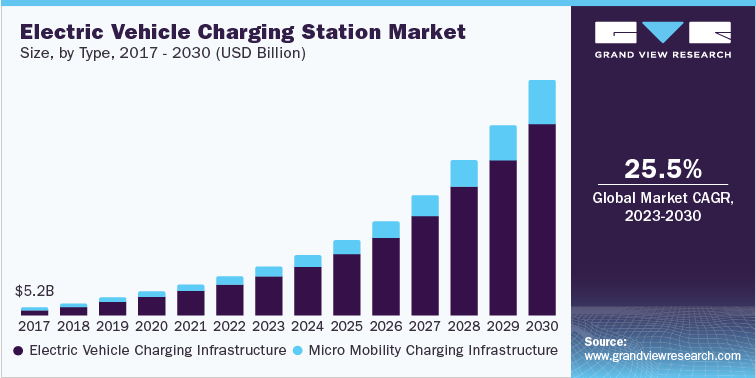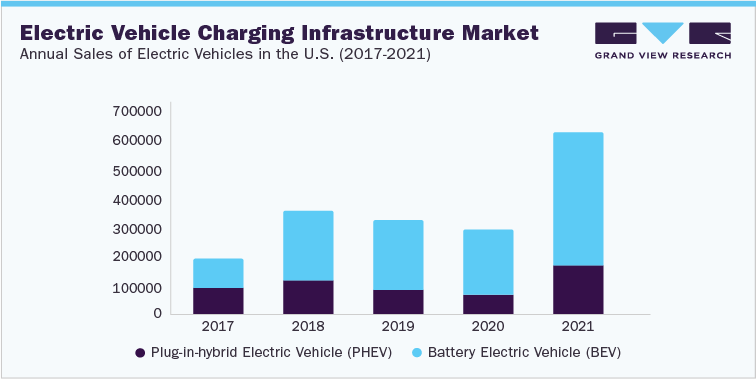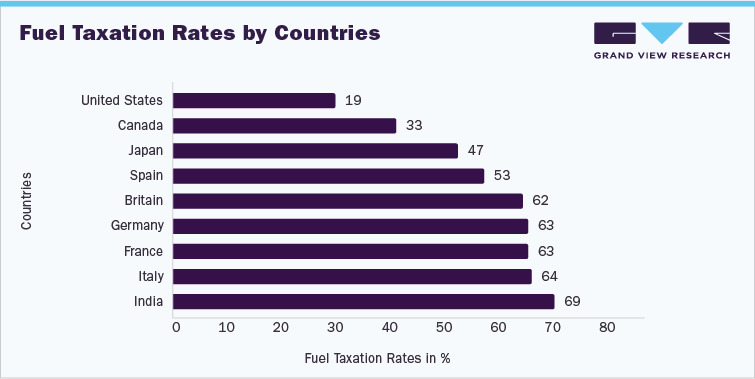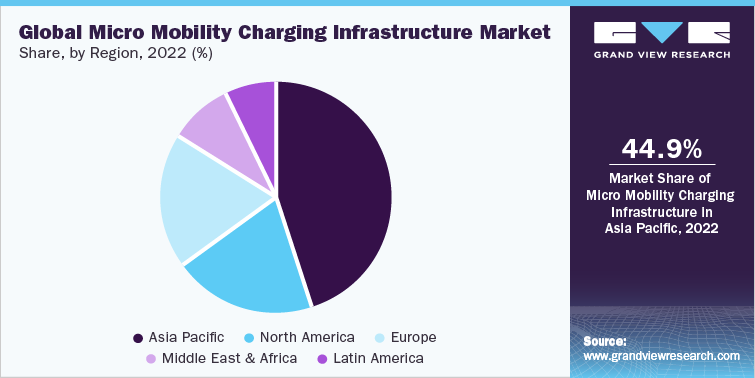- Home
- »
- Sector Reports
- »
-
Electric Vehicle Charging Station Industry Data Book, 2030
![Electric Vehicle Charging Station Industry Data Book, 2030]()
Electric Vehicle Charging Station Industry Data Book - Electric Vehicle Charging Infrastructure and Micro Mobility Charging Infrastructure Market Size, Share, Trends Analysis, And Segment Forecasts, 2023 - 2030
- Published Date: Jul, 2023
- Report ID: sector-report-00193
- Format: Electronic (PDF)
- Number of Pages: 220
Database Overview
Grand View Research’s electric vehicle charging station sector database is a collection of market sizing information & forecasts, regulatory data, reimbursement structure, competitive benchmarking analyses, macro-environmental analyses, and regulatory & technological framework studies. Within the purview of the database, all such information is systematically analyzed and provided in the form of presentations and detailed outlook reports on individual areas of research.
The following data points will be included in the final product offering in 2 reports and one sector report overview:
Electric Vehicle Charging Station Industry Data Book Scope
Attribute
Details
Research Areas
- Electric Vehicle Charging Infrastructure Market
- Micro Mobility Charging Infrastructure Market
Details of Product
- 2 Individual Reports - PDFs
- 2 Individual Reports - Excel
- 1 Data Book - Excel
Cumulative Country Coverage
20+ Countries
Cumulative Product Coverage
25+ Level 1 & Level 2 Products
Highlights of Datasets
- Product Revenue, by Countries
- Type Revenue, by Countries
- End-User Revenue, by Countries
- Competitive Landscape
Number of Tables (Excel) in the bundle
~420
Electric Vehicle Charging Station Industry Data Book Coverage Snapshot
Markets Covered
Electric Vehicle Charging Station Industry
USD 24.26 billion in 2022
25.5% CAGR (2023-2030)
Electric Vehicle Charging Infrastructure Market Size
USD 19.67 billion in 2022
25.5% CAGR (2023-2030)
Micro Mobility Charging Infrastructure
Market SizeUSD 4.58 billion in 2022
25.8% CAGR (2023-2030)
Electric Vehicle Charging Station Sector Outlook
The global electric vehicle charging station industry generated over USD 24.26 billion in 2022 and is expected to grow at a CAGR of 25.5% from 2023 to 2030. The EV charging station market is segmented into various types, such as charger type, vehicle type, connector type, and power source type. The enormous market growth is mostly attributable to the expansion of public and private sector efforts to persuade individuals to switch to electric vehicles (EVs). The use of electric vehicles has been encouraged by several government initiatives, which have also raised consumer awareness of their advantages. The need for electric vehicle charging stations is therefore anticipated to increase dramatically. In addition, according to the International Energy Agency (IEA), in 2022, the electric car market witnessed exponential growth, with sales exceeding 10 million. China accounted for the largest market share, with around 60% of global electric car sales. On the other hand, in 2022, in Europe and the U.S., electric car sales grew by more than 15% and 55%, respectively.

Governments across the globe are focusing on investing in the charging infrastructure and technologies that are supporting the transition to clean and zero-emission electric vehicles. The increasing adoption of electric vehicles, owing to benefits such as lower costs for fuel, energy efficiency, and vehicle maintenance, is expected to create growth opportunities for the electric vehicle charging station market over the forecast period. Moreover, factors such as rising concerns over carbon emissions and government regulations and tax exemptions are further expected to promote the adoption of electric vehicles, which bodes well for the market’s growth. Furthermore, the increasing popularity of the mobility-as-a-service (MaaS) model is also expected to lead to surged adoption of electric vehicles.
Electric Vehicle Charging Infrastructure Market Analysis And Forecast
The global electric vehicle charging infrastructure market size was estimated at USD 19.67 billion in 2022 and is expected to grow at a CAGR of 25.5% from 2023 to 2030. The growth can be attributed to various initiatives taken by governments to promote electric vehicles across the globe. Furthermore, the demand for electric vehicle adoption has been prompted by the increase in carbon emissions and other harmful pollutants from transportation. However, given that the adoption of electric vehicles relies entirely on the availability of charging stations that are easy and convenient to access and in adequate numbers, the demand for an efficient electric vehicle charging infrastructure is also growing simultaneously, which bodes well for the market growth.

The EV charging infrastructure market is segmented based on charger type, connector type, and application. Based on charger type, the segment is further divided into slow chargers and fast chargers. The fast charger segment held the highest share in 2022 and is anticipated to grow at a significant CAGR over the forecast period. The growth can be attributed to the growing adoption of electric vehicles and aspiring targets set by prominent nations investing in the development and expansion of electric vehicle charging infrastructure. Moreover, fast chargers are popular for quickly charging an EV, thus, allowing the user to overcome the anxiety faced over recharging an EV. Fast chargers increasingly utilized in the market are generally DC and rapid AC chargers that are capable of charging an EV in less than 30 minutes. The time efficiency provided by fast chargers is contributing significantly to the segment’s growth. The growth of the EVCI market is directly proportional to the sales of plug-in vehicles. Advances in battery technology and growing emphasis on autonomous vehicles is contributing to the market’s growth. The following figure indicates the annual sales of plug-in electric vehicles in the U.S.
The connector segment is classified into CHAdeMO, Combined Charging System (CCS), and others. The Combined Charging System (CCS) segment is expected to register significant growth over the forecast period. The segment's popularity may be primarily attributable to its ease of use and compatibility with the majority of electric vehicles (including models from BMW, GM, and VW, among others). Additionally, it allows for greater design freedom for electric vehicles because it only needs one charging port, as opposed to two for CHAdeMO connectors, which can't support AC charging. Additionally, two types of CCS connectors are commonly referred to as CCS Type 1 and CCS Type 2. In contrast to Europe, the United States makes considerable use of CCS Type 1 connectors. These elements are accelerating the segment's growth.
The application segment includes commercial and residential. The commercial segment dominated the electric vehicle (EV) charging infrastructure market in 2022 and is expected to retail its dominance over the forecast period. Government initiatives and funding for the installation of publicly accessible electric vehicle charging stations and active participation from electric vehicle manufacturers & utilities are anticipated to drive the commercial segment’s growth over the forecast period.
Asia Pacific and Europe are expected to be the key regions in the market over the forecast period. In the initial six months of 2022, China surpassed the global EV market with a share of 24%. The growth can be attributed to China’s national subsidy program for new energy vehicles (NEVs). Similar growth in demand and adoption of electric vehicles have been observed in other parts of the APAC region, thus, resulting in the expansion of EV charging outlets throughout the region. Moreover, European countries such as the Netherlands, Norway, and the UK are increasingly investing in expanding their EV charging infrastructure. The governments of Norway and the Netherlands have also announced their targets of converting the entire fleet to electric by 2025. Such initiatives are driving the growth of the market in the Asia Pacific and Europe region.
Micro Mobility Charging Infrastructure Market Analysis And Forecast
The global micro mobility charging infrastructure market size was estimated at USD 4.58 billion in 2022 and is expected to grow at a CAGR of 25.8% from 2023 to 2030. One of the main factors influencing the market growth is the rising use of micro mobility vehicles like e-scooters and e-bikes to reduce carbon emissions. There are several uses for micro mobility cars in the commercial and transportation sectors. Manufacturers of micro mobility vehicles are undertaking several endeavors to set up charging networks all around the world. For instance, TIER, a German e-scooter firm, raised USD 250 million from SoftBank in November 2020 to build micro mobility vehicle charging networks throughout Berlin. Such measures are encouraging for the market for micro mobility charging infrastructure during the upcoming years.
The micro-mobility charging infrastructure market is segmented based on vehicle type, charger type, power source, and end-use. Based on vehicle type, the market is further divided into e-scooters, e-bikes, e-unicycles, and e-skateboards. The e-scooters segment dominated the market in 2022 and is expected to register a significant growth rate over the forecast period. Customers prefer e-scooters for shorter travel distances because they require less parking space and have quick recharge times. Most e-scooter charging stations include a designated parking place, which lessens traffic congestion and air pollution caused by vehicles. Additionally, these charging stations are adaptable to any e-scooter design and can be efficiently created based on the area available. These factors are expected to help to boost the segment’s growth. The graph below depicts the fuel taxation rates in percentage across countries as per the Petroleum Planning & Analysis Cell. The increasing crude oil consumption and imports by various countries have led to an increase in fuel taxation rates leading consumers to opt for e-scooters to avoid higher fuel consumption costs, propelling the segment’s growth.

Based on charger type, the market is further segmented as wired and wireless. The wireless segment is expected to exhibit considerable growth over the forecast period. Wireless charging stations offer better convenience and offer faster charging. The wireless micro mobility charging stations are made up of concrete and magnetic coil technology, which provide better vertical wireless power transfer to e-scooters. Increased consumer preference for wireless charging stations, thanks to the vast benefits offered, is encouraging several companies to introduce wireless charging platforms for e-scooters worldwide. For instance, in April 2020, Metz & Intis, a German manufacturer of e-scooter charging infrastructure, created an inductive charging platform for e-scooters. This wireless solution is named Easy Charge and is suitable for a large range of e-scooter models in the market presently. Such initiatives are expected to propel the market’s growth over the forecast period.
Based on power source, the market is further segmented into solar-powered and battery-powered. The battery-powered segment dominated the market in 2022. Battery-powered charging stations can be installed conveniently in public places and privately owned garages. Moreover, citizens mostly prefer battery swapping stations to swap their uncharged batteries with charged ones, allowing them to travel long distances. Moreover, various companies are entering into partnerships with automotive companies to introduce swappable battery stations. For instance, in May 2021, Gogoro, a swappable battery electric scooter maker, announced its partnership with Dachangjiang Group and Yadea in China. Through this partnership, the company will expand its battery swap stations in China. Such initiatives are expected to propel the segment’s growth over the forecast period.
Based on end-use, the market has been further divided into commercial and residential. The residential segment dominated the market in 2022 and is expected to register a significant growth rate over the forecast period. Factors such as growing traffic congestion and increasing urbanization have led to the increased use of micro mobility vehicles for transportation. Moreover, people are becoming more aware of the vast benefits of eco-friendly vehicles, thereby accelerating the demand for micro mobility vehicles in the residential sector. Furthermore, government subsidies and tax incentives under smart city projects for e-scooters are expected to create more awareness about these vehicles. Such initiatives are anticipated to create new growth opportunities for the residential segment over the forecast period.

Asia Pacific dominated the global micro mobility charging infrastructure market in 2022 and accounted for the maximum share of the overall revenue. The growth can be attributed to various initiatives by governments aimed at promoting the use of micro mobility vehicles. The region has a high population growth rate, leading to traffic congestion and constantly reducing vehicle parking spaces, especially in urban areas. This has led to the increased adoption of micro mobility vehicles, which are convenient for traveling short distances and require fewer parking spaces. Moreover, several automobile companies based in Asia Pacific countries, such as India and China are investing in micro mobility charging infrastructure and developing e-scooters, which could accentuate the growth prospects of the regional market. For instance, in April 2021, Ola Electric Mobility Pvt Ltd. announced its plan to build a charging network for e-scooters across India. In December 2020, the company received funding of USD 326 million from Japan’s SoftBank Group for developing electric scooters in the Indian state of Tamil Nadu. Such initiatives are further boosting the region’s growth.
Competitive Landscape
The key market players have developed novel concepts and ideas and upgraded the current set of products to sustain the intense competition in the market. The players have adopted new product development as their key developmental strategy to cater to the increasing demand from end-users. The electric vehicle charging infrastructure market and micro mobility charging infrastructure market can be described as moderately fragmented markets characterized by the presence of various prominent players driving competition by pursuing various strategies aimed at long-term sustenance. These strategies include geographical expansion, product innovation, a strong focus on R&D activities, strategic partnership agreements, and joint ventures. For instance, in August 2020, Robert Bosch GmbH announced the expansion of its eBike PowerStation business in Europe. Bosch eBike systems have cooperated with Swabian Alps Tourism Association (SAT) and have installed six PowerStations across the SAT so that e-mountain and e-trekking eBike riders do not face issues with charging their eBikes. Moreover, the company has also decided to install these PowerStations in the urban areas of Europe to expand its product offerings. Such initiatives are driving innovation and competition, thereby propelling the market’s growth.
Prominent Market Players
-
ChargePoint, Inc
-
Tesla, Inc
-
ABB
-
BP Chargemaster
-
ClipperCreek, Inc
-
Bikeep
-
Robert Bosch GmbH
-
Get Charged, Inc
-
Flower Turbines
-
Ather Energy
Share this report with your colleague or friend.
GET A FREE SAMPLE
This FREE sample includes market data points, ranging from trend analyses to market estimates & forecasts. See for yourself.
![gvr icn]()
NEED A CUSTOM REPORT?
We can customize every report - free of charge - including purchasing stand-alone sections or country-level reports, as well as offer affordable discounts for start-ups & universities.
Contact us now to get our best pricing.
![esomar icon]()
ESOMAR certified & member
![ISO]()
ISO Certified
We are GDPR and CCPA compliant! Your transaction & personal information is safe and secure. For more details, please read our privacy policy.
We are committed towards customer satisfaction, and quality service.
Client Testimonials

"The quality of research they have done for us has been excellent..."
ISO Certified




